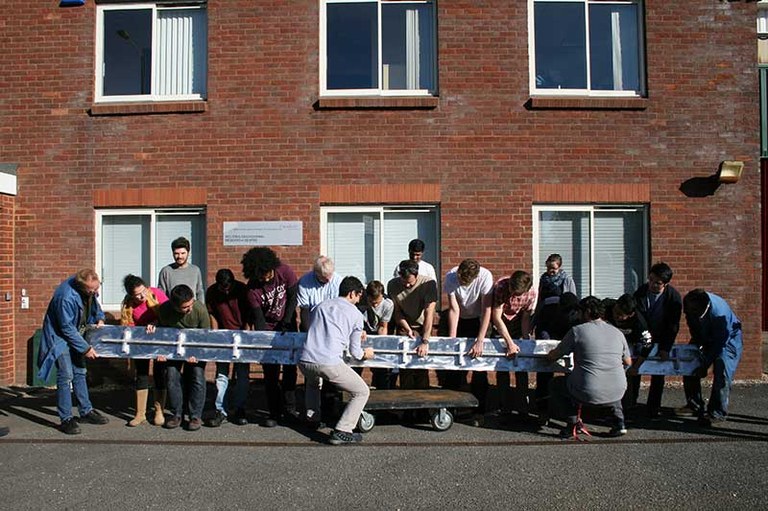 One of the things that excites people the most about metal additive manufacturing is its capability to produce big parts – really big parts. The technology has allowed users in every area of manufacturing to create large, complex parts in one piece, cutting costs and saving material and time by eliminating the need to separately produce and then assemble multiple components to create one part.
One of the things that excites people the most about metal additive manufacturing is its capability to produce big parts – really big parts. The technology has allowed users in every area of manufacturing to create large, complex parts in one piece, cutting costs and saving material and time by eliminating the need to separately produce and then assemble multiple components to create one part.
So how big are we talking in terms of metal 3D printed parts? According to researchers at Cranfield University, they may have just produced the biggest one ever. The double-sided spar, which was 3D printed from aerospace-grade aluminum on the UK university’s new 3D printer, is six meters long and weighs 300 kg – that’s nearly 20 feet and over 660 pounds. “Big” really doesn’t cut it as a description.
The spar was printed using wire and arc additive manufacturing (WAAM) technology, a lesser-known metal 3D printing method that involves the use of an electric arc to melt metal wire, setting it apart from the more typical metal powder additive manufacturing techniques. Typically, the electric arc is generated with common, off-the-shelf welding equipment, with the printing process itself controlled by robotics or computer gantries. It’s a fascinating technique that is still being heavily researched, and while we don’t see it very often, it’s been responsible for some amazing creations, like this all-metal bicycle.
Cranfield University leads the WAAMMAT Consortium, a group of 20 industry partners and 13 additional universities working together to further develop and commercialize WAAM technology. The 3D printed spar was produced as a means of testing the capabilities of Cranfield’s new printer, as well as to learn more about the challenges of printing such a large part in one piece. WAAM is an ideal technology for 3D printing massive parts, and its further development could have a huge impact on the aerospace industry in particular, as well as oil and gas, automotive, energy and other industries.
“Hundreds of millions of pounds are spent on medium to large-scale components by the aerospace industry each year. There is great potential for significant cost savings in terms of waste and production efficiency if we can transform the way these parts are manufactured,” said Professor Stewart Williams, head of Cranfield University’s Additive Manufacturing program. “This demonstration clearly shows the potential of the WAAM process with this newly-acquired machine for changing future manufacturing processes.”
The spar was designed and printed by a group of MSc students (Cranfield is a postgraduate-only school) who estimate that WAAM can reduce the cost of producing large metal components by 70% over traditional machining methods. It can also reduce lead time from more than a year to a few weeks. Thanks to the work and research the WAAMMAT Consortium has been putting into the technology, WAAM has been found to produce parts with better material properties than those manufactured by other means, without the size restrictions of other additive manufacturing methods.
The WAAMMAT Consortium is supporting the qualification programs of several large aerospace original equipment manufacturers (OEMs), and the Cranfield University team is already working on upgrading their newest printer to accommodate the production of titanium parts. They’ve also developed and added a local shielding device. We’ll continue to keep an eye on the university and the consortium as they drive the advancement of this very different – and very exciting – method of 3D printing. Discuss further in the Biggest 3D Printed Metal Ever forum over at 3DPB.com.
[Sources/Images: Cranfield University / WAAMMAT Consortium]Subscribe to Our Email Newsletter
Stay up-to-date on all the latest news from the 3D printing industry and receive information and offers from third party vendors.
Print Services
Upload your 3D Models and get them printed quickly and efficiently.
You May Also Like
Heating Up: 3D Systems’ Scott Green Discusses 3D Printing’s Potential in the Data Center Industry
The relentless rise of NVIDIA, the steadily increasing pledges of major private and public investments in national infrastructure projects around the world, and the general cultural obsession with AI have...
3DPOD 260: John Hart on VulcanForms, MIT, Desktop Metal and More
John Hart is a Professor at MIT; he´s also the director of the Laboratory for Manufacturing and Productivity as well as the director of the Center for Advanced Production Technologies....
Etsy Design Rule Change Reduces Selection of 3D Printed Goods
Online marketplace Etsy has implemented a rule change requiring all 3D printed goods on the site to be original designs. The update to the site’s Creativity Standards states, ¨Items produced using...
E-Beam OEM Wayland Additive Partners with USC Racing to 3D Print Titanium Exhaust Collector
Every year, standards organization SAE International holds a competition called Formula SAE, in which students from both undergraduate and graduate programs design, build, and race small formula-style race cars. For...



































